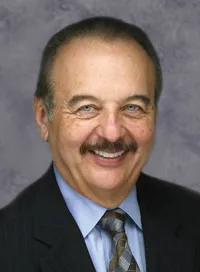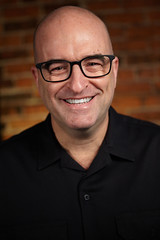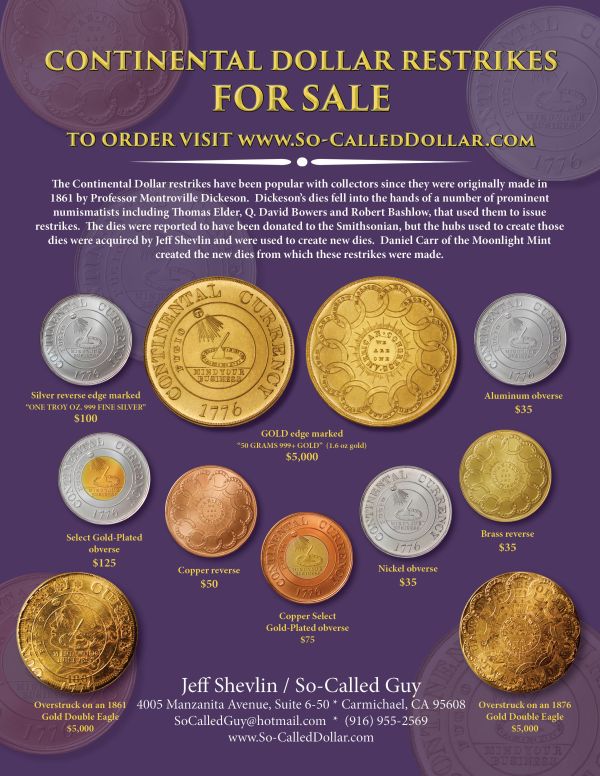
PREV ARTICLE
NEXT ARTICLE
FULL ISSUE
PREV FULL ISSUE
RON GILLIO INTERVIEW, PART THREEGreg Bennick's latest interview for the Newman Numismatic Portal is with longtime dealer Ron Gillio. Here's the third of five parts, where Ron discusses antiques and buying U.S. coins in Europe. -Editor GREG BENNICK: I like it. So, you mentioned Western Coins and Antiques. I know I brought it up slightly out of sequence before. What could you tell us about Western Coin and Antiques?
GREG BENNICK: Now, tell me this, the connection with antiques since you haven't brought up Antiques before. Western Coin certainly makes sense. Tell me about your connection to antiques and what was the association there? RON GILLIO: Well, most of the antiques I dealt in were Western paintings. I dealt in Tiffany lamps, Oriental Persian rugs, and California paintings. But I did it more because I liked it. I'm talking from my house and my whole house is like a museum everybody says when they come over because I like paintings and I like collecting things. I'm still a big collector of all kinds of things. But I didn't really deal that much in antiques, a little bit. GREG BENNICK: What sort of things do you love to collect? Meaning, if we were in your house right now, what would we predominantly see in terms of your favorite collections of your favorite items? What are the things that you love to collect the most, say? RON GILLIO: Well, I collect European medals with ships on it and historical U.S medals, gold medals. I like all kinds of medals with different designs on them. I don't have anything really rare, but I like medallions and I like Tiffany lamps. I have some Tiffany lamps and I have California paintings. I have a lot of Western art. So, just a little bit of everything, really. GREG BENNICK: Great. So, Western Coin and Antiques is running. People are coming in, buying, selling coins, buying, selling these specific types of antiques. Now, throughout your career, and I might have been around this time or shortly thereafter, buying overseas became a huge part of what you do. So, as I understand it, you went to Switzerland first or was it just a general trip to Europe first? How did it come about that you started integrating going to Europe, finding coins, buying coins, and I'm assuming bringing them back to the United States and selling them. But please, enlighten us and let us know the story about going to Europe or, if I'm right, Switzerland the first time to buy coins.
RON GILLIO: Okay. So, yes, that's been a big part of my business. It still is buying
coins in Europe. At this present time, for the last 16 years, I'm a consultant for Stacks
Bowers and I do it for them. It's been working out very well. But to get started, it
was actually Bob Johnson, San Francisco, that kind of introduced me to the
European market because I was buying these 20s. We talked about the two $20s I
bought from, but through the 60s, I continued to buy and sell $20 gold pieces, buying
mostly from him. And another person I bought a lot of coins from was a FJ Vollmer,
somewhere in the Midwest, Minnesota or someplace. But those are the two people I
was buying from and I was selling them to different people in California, mostly,
not too much out of the state of California. I didn't have that much money, so I had
to turn them quickly.
But then he told me that he was buying most of them from a couple of sources in
Europe and that's where the coins were. So, I started researching and found out how
all the $20 gold pieces got to Europe during the 1930s when Roosevelt took us off
the gold standard. So, in 1970, I made my first trip. You're correct, my first trip was
to Switzerland, was to Zurich, Switzerland, and that was either 1970 or 1971. And I
had just so much money to spend. And I don't remember what I had to spend, but it
lasted about an hour because there were so many coins there.
So, one thing in later years, Bob Johnson would finance me and we'd go together
and he once told me, and this is so true and I remember it till today, that you'll never
buy all the coins in Switzerland or in Europe. There's more coins than there is money.
And he was so right because I was still buying coins. Not as many as we used to do,
but there's still coins there. But that was kind of my experience. Started in 1970
buying coins in Switzerland, but then what really prompted me…I went on that trip,
came home, sold the coins. And then one day a doctor walks in my store in Santa
Barbara and says he wants to buy some $20 gold piece. He heard I had $20 gold
pieces from another customer of mine in Santa Barbara. And I showed him some
$20 gold pieces and they were at the time around $100 a piece, a little under $100
apiece. And he said, okay, he said, how many of these do you have? And I had, I
think 20 at the time, he bought the 20. And he said he wanted to buy 100 of them.
And at the time I was buying a lot of coins at that time from a guy named Harry
Gordon, who was another guy that went to Europe a lot. He was my senior. He was
about the age of Bob Johnson at the time. And so, I bought, I bought the 100 from
him. And the doctor took those. And then he, when he picked those up, he said he
wanted to buy a thousand. I said, GREG BENNICK: So why do you think it is that there were so many Vermont and colonials in London at the time? RON GILLIO: Well, it wasn't just Vermont Colonials. There was Vermont's, Connecticut's. I mean a continental dollar I bought one time in London that just seemed to have ended up there over the years. People traveling to the Americas during that period of time when Colonial coins were issued or not, even after they were issued, people would be going there in the 1780s, 1790s, and I believe in the early 1800s and picking up odd things from America and they just would bring them back and they just ended up there. GREG BENNICK: But the gold coins were different though because you were mentioning the gold standard. Could you tell us a little bit just historically when the gold standard came around, why there was this flood out of the country, just in case people haven't heard of that experience? RON GILLIO: Well, I mean, there was a flood out of the country, people taking them out of the country, taking them to Europe, taking them to Canada, but also the payments on different debts at that time, the governments would take coin, not gold bars, they would take U.S. coin as payment and debt and also big companies would have contracts, they get payment in $20 or U.S. gold coins, a lot of those U.S. gold coins. And the thing is that they kept them there, they didn't do like the Fort Knox did here, melt the coins, they ended up staying in the vaults in Europe and that's for payment and there was just millions of coins sent over there in the 30s and the 40s. GREG BENNICK: And did you find that there were just far less coins to buy here in the U.S. or were the prices at which you could buy those coins far better in Europe or both maybe? RON GILLIO: There's far more coins in Europe and a better deal. I mean, I can remember my first trips to Switzerland, the main street in Zurich is called the Bahnhofstrasse and on the Bahnhofstrasse at the time, which is not current anymore, the banks don't deal in coins in Switzerland anymore to any extent. But during the 70s and 80s, you could go down, you could start one of the Bahnhofstrasse and go to one bank and they would have a chart, they would have half eagles, eagles, double eagles, sovereigns, Swiss 20 francs and they would have the buy-sell price and you could just ask them for double eagles and they would just dump out double eagles and they wouldn't be sorted. There would be St. Gaudens and Liberties mixed, there would be dates in there, you could find CC $20s. It was a gold mine, you might say. o, you used to go from one bank to another and buy coins. Like I said earlier, I'd always run out of money even when I had money from Bob Johnson. We'd go together, we'd always run out of money, but the coins are much cheaper over there and more available and bring them back to the United States and sell them. GREG BENNICK: Incredible. These days, obviously, quite long gone, but is there still a market to do this sort of thing, to go to Europe and look for American coins to bring home to sell? Are there still people doing that? And perhaps you're still doing that, as you mentioned earlier. RON GILLIO: Yeah, I'm still doing it, but not to that extent during that time or the quantities. There's still coins there. PCGS just opened up an office in Paris, so they're grading coins. So, what I get offered now and what people have mostly are graded coins, just like here. They're still there, but not like they used to be. GREG BENNICK: I love the idea of you going to Switzerland, having somebody dump out a bag of $20 gold pieces and you running out of money in one hour. That's pretty fun. RON GILLIO: Of course, I can tell the same stories about going to coin shows, buying, and selling coins and running out of money and figuring out that I had to sell some coins before I could buy more, or else I couldn't make my checks good. GREG BENNICK: I think anyone who's passionate about collecting has had the same experience, where I know that I've walked into coin shows in the past and been very excited to be at the coin show. And within five minutes, I've expended the entire amount of money that I brought to the show and start thinking to myself, okay, now, what can I do? Where can I move? What can I do in order to keep this going? So, it sounds like you've successfully done that, though, for the last seeming 50 years of buying, selling, and trading. So, you must be doing something right. RON GILLIO: Yeah, it'll be 60 years. My first ANA convention was Cleveland in 1964. So, this year, coming up in Chicago, I'll get my 60-year pin. I've been every ANA for 60 years, except for the one during COVID. So, this is my 59th. I just attended in Pittsburgh. GREG BENNICK: Fantastic. Yeah, and I know that there was definitely some fanfare around you. We'll get to that in a little bit about your experience in Pittsburgh and winning awards and whatnot. But I'll be in Chicago. I'll look forward to you receiving your 60th. That's really exciting. In terms of those ANA conventions over the years, are there ones that you remember in particular or people that you remember in particular? You mentioned Abe Kosoff earlier, and he was supposedly, you know, this great dresser and looked really flashy and that sort of thing. I don't know if that's your recollection of him, but are there either him or others that you remember that stand out to you as people who were standouts in your memory?
To watch the complete video, see:
To read the complete transcript, see:
To read the earlier E-Sylum article, see:
Wayne Homren, Editor The Numismatic Bibliomania Society is a non-profit organization promoting numismatic literature. See our web site at coinbooks.org. To submit items for publication in The E-Sylum, write to the Editor at this address: whomren@gmail.com To subscribe go to: https://my.binhost.com/lists/listinfo/esylum All Rights Reserved. NBS Home Page Contact the NBS webmaster 
|


